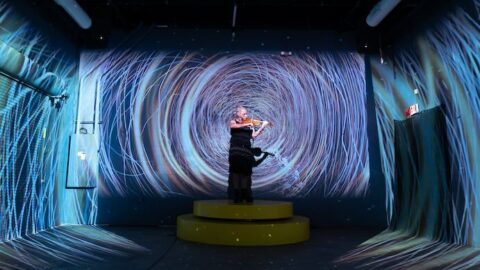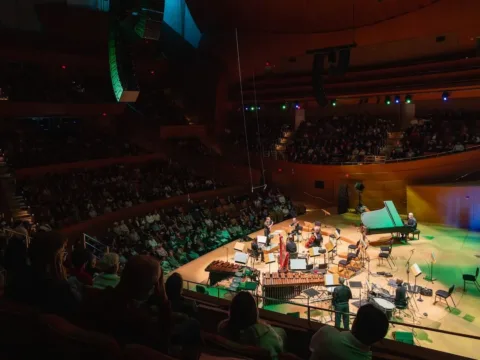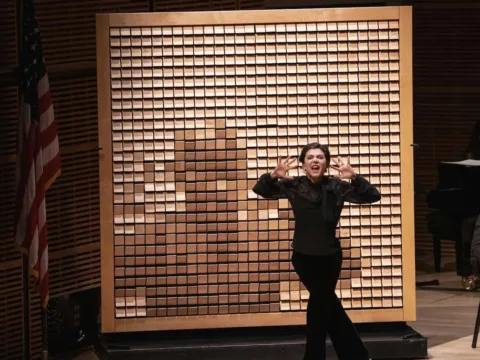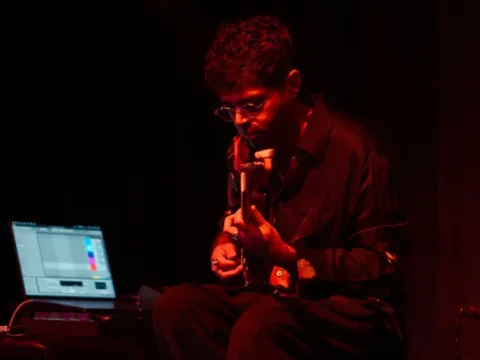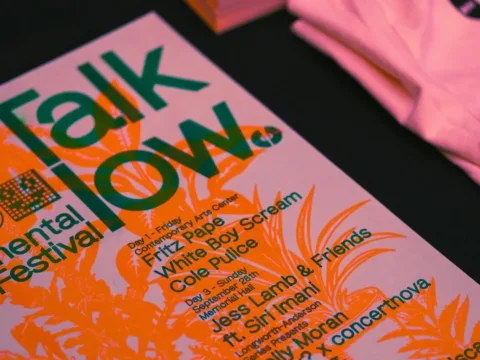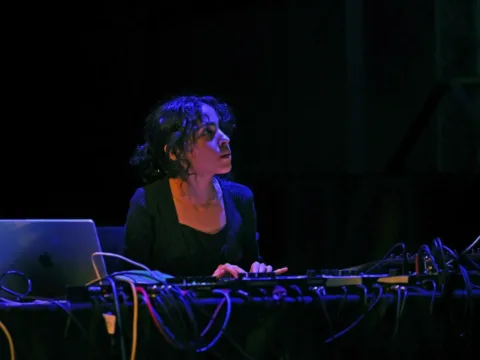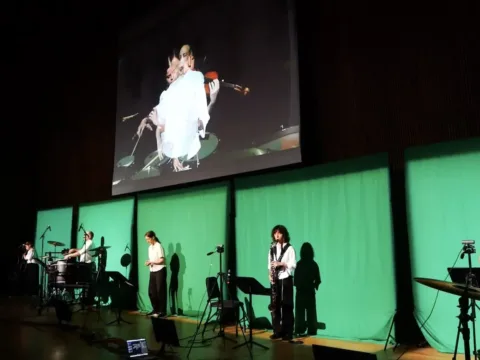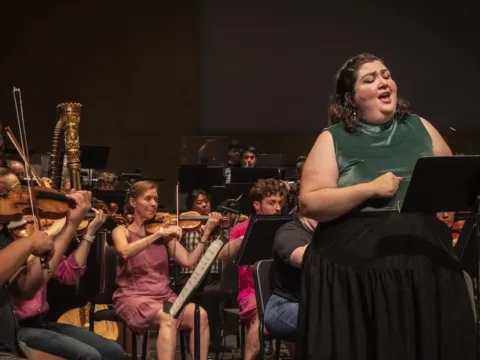I don’t need many reasons to enter a room filled with colored lights. It’s one of my favorite things, and in some ways, I love it more than listening to music. But on Oct. 19 at Alice, a bar in Cincinnati’s Over-the-Rhine neighborhood, I didn’t have to choose between the two. Presented by concertnova, a local artist collective known for creating multi-sensory performances, “Echo Play” featured violinist Max Ball and violist-violinist Jasper de Boor with visual projections by media artist and musician Xuan. The 15-minute shows at 3pm, 4pm, and 5pm were dynamic and required audience members to stay aware and alert in a way that was refreshing and stimulating.
“Echo Play” overlapped with BLINK, a biannual arts and light festival that has crept from downtown Cincinnati to include Covington and Newport, KY. Over the course of four evenings, the city turns into a mini Manhattan: bumper-to-bumper traffic; crowds of people in the streets looking at new murals, light projections that bring images to life, and drone shows over the Ohio River.
I attended each 15-minute “Echo Play” show on Saturday. I wanted to fully experience the echo of familiarity and change in the performances and visuals, which were designed by Xuan to be in conversation with the two programmed works: A Mere Breath by Bobby Ge, and Knee Play 2 by Philip Glass. With the audience seated on button chairs under the large disco ball in Alice’s back room, the set began with Max Ball playing Ge’s work for violin and electronics. As Ball sent out icy, singing passages into the space, a silvery mass was projected against the black wall behind them.
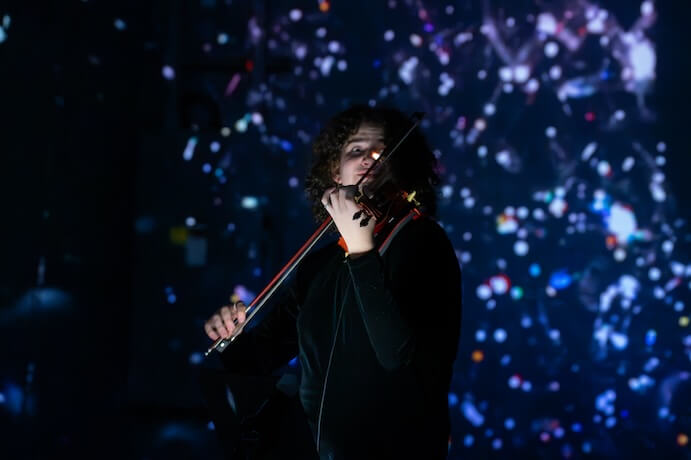
Though intended to be seen once, watching “Echo Play” three times led to changes in perception and connection as new information was added with each watch. A Mere Breath is built upon echoes between the soloist and electronics; it’s very much a duet that moves from cold detachment to vibrant depth. This shift was mirrored in Xuan’s visuals; the diamond sparkles that initially encircled the mash of silvery, liquid mercury expanded to all three walls as Ball reached the formal apex of the piece: an explosion of consonant hope as the room became enveloped in red.
Almost immediately after the applause for Ball, de Boor began Knee Play 2 for solo violin from the back of the room, walking toward the circular yellow dais at the front. This projection was electric and sizzling: thick and spidery circles of light spun relentlessly, bathing de Boor in gold, yellow, and red light. This reflected the frenetic, repetitive minimalism of the work itself; a good portion of the piece is on the lower three strings.
de Boor is the violist of the Poiesis Quartet, of which they and Ball are members. On their violin, de Boor pulled out a refreshing tone of grit and granular dimension that enhanced the vibrating tension of the projection. The final section was so quick that de Boor pressed their bow as far as they could into the string, creating a satisfying metallic timbre to match the electric fire of the images. As soon as the work ended, the projection stopped and we were bathed in darkness.
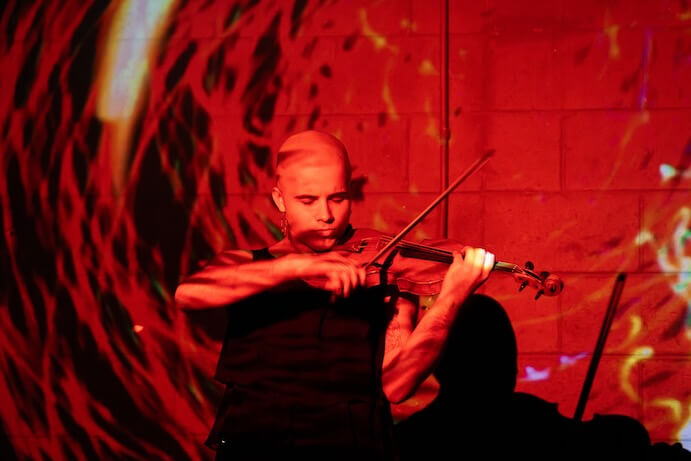
Before each performance, concertnova executive director Brianna Matzke spoke about the organization’s mission to bring classical music into unconventional spaces through multidisciplinary collaboration. “Echo Play” was a beautiful expression of that; by commissioning Xuan to create projections that engaged with these two pieces, it is now possible for musicians to perform A Mere Breath and Knee Play 2 with a visual component. It’s not only a matter of the presentation of the music being changed; the projections effectively change the context of the music. Neither audience nor performer can fully disconnect from such a multi-sensory experience; there is always something to consider, see, hear, and connect to in order to make sense of it.
Compared to the first two shows, which were sparsely attended, the final performance of “Echo Play” was so full that chairs from the bar were needed. A family with two children sat at the front during this last performance; when the lights dimmed, one child said, “I can’t see anything,” which led to a resonant group chuckle. It was my favorite performance because people from different places, of different ages, of different musical experiences and tastes, were listening to something new, made with passion and heart.
To say it was an exciting experience feels trite. To say it was revolutionary strips away the emotional specificity. To say, “more organizations need to do this” has no teeth. So I’ll just say, “more please!”
I CARE IF YOU LISTEN is an editorially-independent program of the American Composers Forum, and is made possible thanks to generous donor and institutional support. Opinions expressed are solely those of the author and may not represent the views of ICIYL or ACF.
You can support the work of ICIYL with a tax-deductible gift to ACF. For more on ACF, visit composersforum.org.
